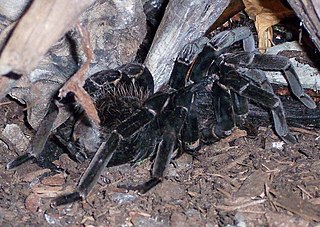
Chiasmocleis is a genus of microhylid frogs. They are found in tropical South America north and east of the Andes. Their common name is humming frogs or silent frogs, the latter referring to the formerly recognized Syncope.
Chiasmocleis anatipes is a species of frog in the family Microhylidae. As currently known, it is endemic to northeastern Ecuador, but it is likely to occur also in adjacent parts of Peru and perhaps Colombia too. The specific name anatipes refers to the "duck-like" feet of this frog, characterized by extensive webbing between the toes. Common name Santa Cecilia humming frog has been proposed for this species.
Chiasmocleis atlantica is a species of frog in the family Microhylidae. It is endemic to Brazil. Its natural habitats are subtropical or tropical moist lowland forests and intermittent freshwater marshes. It is threatened by habitat loss.

Chiasmocleis bassleri is a species of frog in the family Microhylidae. It is found in the Amazon biome of Brazil, Colombia, Ecuador, Peru, and Bolivia. The specific name bassleri honors Harvey Bassler, an American geologist and paleontologist. Common name Bassler's humming frog has been proposed for this species.
Chiasmocleis capixaba is a species of frog in the family Microhylidae. It is endemic to Brazil. Its natural habitats are subtropical or tropical moist lowland forests and intermittent freshwater marshes. It is threatened by habitat loss.
Chiasmocleis carvalhoi is a species of frog in the family Microhylidae. It is found in Colombia, Peru, and Brazil. Its natural habitats are subtropical or tropical dry forests or moist lowland forests and intermittent freshwater marshes. It is threatened by habitat loss from farming and logging.

Chiasmocleis cordeiroi is a species of frog in the family Microhylidae. It is endemic to Bahia in eastern Brazil. It is known from Camamu, its type locality, and from few other localities on both sides of the De Contas River. The specific name cordeiroi honors Paulo Henrique Chaves Cordeiro, a Brazilian biologist. Common name Cordeiro's humming frog has been coined for this species.
Chiasmocleis gnoma is a species of frog in the family Microhylidae. It is endemic to Brazil. Its natural habitats are subtropical or tropical moist lowland forests, intermittent freshwater marshes, and plantations . It is threatened by habitat loss.

Chiasmocleis hudsoni, also known as Hudson's humming frog, is a species of frog in the family Microhylidae. It is found in French Guiana, Suriname, Guyana, Guianan Venezuela, Colombia (Amazonas), and Amazonian Brazil. Chiasmocleis jimi has been included in this species but the most recent genetic analyses support its recognition as a distinct species; both species might include further distinct lineages that warrant recognition as species.

Chiasmocleis leucosticta is a species of frog in the family Microhylidae. It is endemic to Brazil. Its natural habitats are subtropical or tropical moist lowland forests and intermittent freshwater marshes. It is threatened by habitat loss.

Chiasmocleis schubarti is a species of frog in the family Microhylidae. It is endemic to Brazil. Its natural habitats are subtropical or tropical moist lowland forests and intermittent freshwater marshes. It is threatened by habitat loss.

Chiasmocleis ventrimaculata, also known as the dotted humming frog, is a species of frog in the family Microhylidae. It is found in Bolivia, Brazil, Colombia, Ecuador, and Peru. Its natural habitats are subtropical or tropical moist lowland forests, swamps, and intermittent freshwater marshes.

Myersiella is a genus of frogs in the family Microhylidae. It is monotypic, being represented by the single species, Myersiella microps. It is endemic to southeastern Brazil and occurs in Espírito Santo, Rio de Janeiro, southeastern Minas Gerais, and southeastern São Paulo state. The genus name honors George S. Myers. The genus is sometimes known as the elongated frogs, while the sole species is known as Rio elongated frog.
Chiasmocleis antenori, also known as the Ecuador silent frog, is a species of frog in the family Microhylidae. It is found in eastern Ecuador, eastern Peru, and western Brazil (Acre). It might be a species complex.

Xenesthis immanis, the Colombian lesser black tarantula, is a terrestrial bird spider (tarantula) originating from Colombia. It is a relatively large spider with a body length reaching 6–7 cm and a length width reaching 19-22 cm. It frequently displays a commensal or mutualistic relationship with the microhylid frog Chiasmocleis ventrimaculata. The relationship described is one where the spider may protect the frog and its eggs from predators while the frog protects the spider's eggs from ants. It has also been observed closely associating with Hamptophryne boliviana, another microhylid.

Chiasmocleis quilombola is a species of frogs in the family Microhylidae. It is endemic to southeastern Brazil and found between the Doce River and the Mucuri River in the state of Espírito Santo. The specific name quilombola is derived from quilombo, the name for a Brazilian community founded by escaped slaves.

Poecilotheria subfusca, or the ivory ornamental, is a spider in the tarantula family, Theraphosidae. It is endemic to Sri Lanka. As of February 2019, the World Spider Catalog regarded Poecilotheria bara as a synonym. Other sources, particularly in the pet trade, have treated highland and lowland forms as distinct species, with the lowland forms being P. bara.
Ulisses Caramaschi is a Brazilian herpetologist specializing in neotropical frogs. He works at the National Museum of Brazil and is a professor at its Department of Vertebrates.
Chiasmocleis royi, the reticulated humming frog, is a frog endemic to Bolivia, Brazil, and Peru. This frog often shares burrows with tarantulas in what may be a mutualistic or commensalistic symbiosis.
Chiasmocleis lacrimae, the central humming frog, is a frog in the family Microhylidae. It is endemic to Brazil, where it lives in lowland forest habitats.










